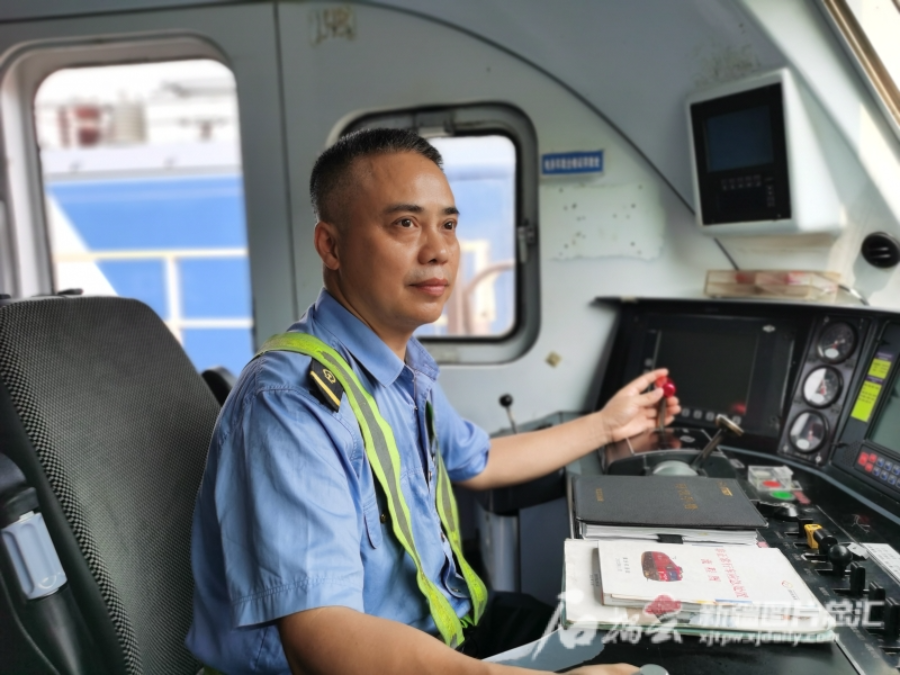Road of Prosperity: The first electric locomotive driver of the China-Europe Railway Express
On Aug. 12, 2023, intermittent clouds shaded the sun, bringing a cool respite to Chongqing.
At Xinglongchang Railway Station in Shapingba district, situated in southwest China's Chongqing Municipality, locomotive driver Jiang Tong climbed into the cab and readied for departure. He released the brake and nudged the control handle forward. With a gentle start, the train began its journey as he turned to look forward.

Photo taken on Aug. 12, 2023, shows Jiang Tong checking the locomotive information in the cab. [Photo by Shiliuyun-Xinjiang Daily/Lu Fengba]
Employed by the Chongqing Depot of China Railway Chengdu Group Co., Ltd., Jiang is distinctively recognized as the first driver of the Chongqing-Xinjiang-Europe International Railway train.
"To this day, I still can't believe that I am the first one to drive the China-Europe freight train," said Jiang, sitting in the driver's cab, his mind filled with images of the inaugural run.
Rewinding 12 years, being the first to drive the China-Europe freight train was both an honor and a profound responsibility for Jiang. To guarantee the train's safe operation, he practiced simulated driving in the classroom, honed his operational skills, and learned from past experiences. He borrowed books on locomotive principles and construction blueprints, poring over them meticulously. He'd often be found in the mechanical room, comparing the information with tangible components, familiarizing himself with the various parts of the locomotive, and mastering their working principles.
As the departure date for the China-Europe freight train's inaugural drew near, Jiang's anticipation grew: "I kept practicing the driving movements in my mind over and over again."
As the darkness gave way to dawn on March 19, 2011, Jiang Tong dressed in his uniform, wearing a cap and tie. He carefully double-checked everything and arrived in the driver's cab 15 minutes ahead of schedule. After inspecting the locomotive's exterior, he entered the cab for another comprehensive inspection, ensuring all was in place. Settling in, he adjusted the controls and eagerly awaited the departure signal.
"It was as lively as the New Year," Jiang Tong reminisced. Though over a decade has elapsed, the departure of the first China-Europe freight train remains vividly etched in his memory, becoming an indelible part of his life. "There was a crowd of people outside, constantly taking pictures with their cameras," he recalled.
After receiving the signal from the station master, Jiang blew the train's long whistle, released the brake, and pushed the forward handle. With the train horn echoing, the China-Europe freight train, laden with electronic goods, commenced its journey from Tuanjiecun Station in southwest China's Chongqing Municipality. It journeyed through cities like Dazhou, Ankang, Xi'an, Lanzhou, Urumqi, and Alashankou before exiting China and finally docking at Duisburg, Germany. This 16-day odyssey spanned 11,179 kilometers and heralded the beginning of the China-Europe freight train service.
Yet, what remains lesser known is that Jiang wasn't tasked with navigating the entire stretch from Chongqing to Duisburg. The train was operated in relays by multiple drivers. Jiang Tong's leg of the relay was a 242-kilometer journey from Tuanjiecun Station to Dazhou in Sichuan Province – the maiden stretch of this extensive route.
A mere three hours post-departure, the China-Europe freight train smoothly reached Dazhou in Sichuan Province, marking the successful completion of Jiang's segment. The subsequent portions of the journey were expertly handled by a relay of drivers.
"After getting off the train, I couldn't calm down for several days," Jiang shared. In the rail yard, the comings and goings of extended freight trains have become a commonplace sight for him. But whenever the China-Europe freight trains roll by, he finds himself instinctively pausing for a longer look.
Years have passed quickly. Following Chongqing's pioneering international freight service to Europe, other cities like Urumqi, Xi'an, Chengdu, Zhengzhou, and Yiwu have introduced similar services to Central Asia and Europe. Since the Belt and Road Initiative was proposed, China-Europe Railway services have developed rapidly nationwide.
In the early days of the China-Europe Railway Express, there were only one to two trains every week. Since the Belt and Road Initiative was put forward, the frequency of trains shuttling between Chongqing to Central Asia and European markets via Xinjiang has increased. The highest number of trains operated is seven to eight trains per week. To date, a cumulative total of 14,000 trains have run on nearly 50 stable routes, which have emerged as pivotal international trade arteries crisscrossing Eurasia. The variety of goods transported has expanded as well, from initially ferrying electronic products and vehicles to now including a diverse array of items, including smart devices, vehicle parts, cross-border e-commerce products, and light industrial goods.
Sometimes, while browsing the aisles of a supermarket, upon spotting foreign merchandise, Jiang swells with pride, pondering, "Maybe this is something we transported."
Next year, Jiang will retire, but he remains enthusiastic. Whenever he's called to duty, he swiftly dons his cap, slings on his backpack, and confidently steps into the locomotive's cabin. "From Chongqing to Europe through Xinjiang, even on my last day of work, I want to drive the first leg of the freight train with excellence," he said.
When asked if he had ever considered driving the China-Europe freight train all the way to Xinjiang, Jiang Tong immediately responded, "Of course, I have thought about it. I have always dreamed of driving to Xinjiang and even to Europe."
"However, the specification of the job requires us not to operate the train outside our jurisdiction," Jiang noted with a touch of regret. "But after my retirement next year, I will go to Alashankou and see how the China-Europe freight train leaves the country."
Source: TIANSHANNET
Photos
Related Stories
- Chinese guitar-making industry rides on wave of Belt and Road Initiative
- Lao PM vows closer cooperation to support Belt and Road Initiative
- Presentation of Belt & Road Portal (Russian version) held in Moscow
- Chinese, Myanmar scholars discuss prospects of BRI cooperation
- Chinese man builds career, finds love through construction of BRI
- Blossoming agricultural cooperation along Belt and Road
- BRI countries share cooperation hopes ahead of China-Arab expo
- Belt & Road cooperation contributes to promoting global human rights cause: experts
- Scholars, officials expect more Belt and Road cooperation for green development
- Experts, scholars discuss BRI contributions to global human rights cause in Geneva
Copyright © 2023 People's Daily Online. All Rights Reserved.









